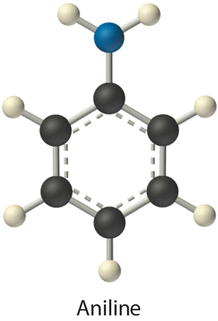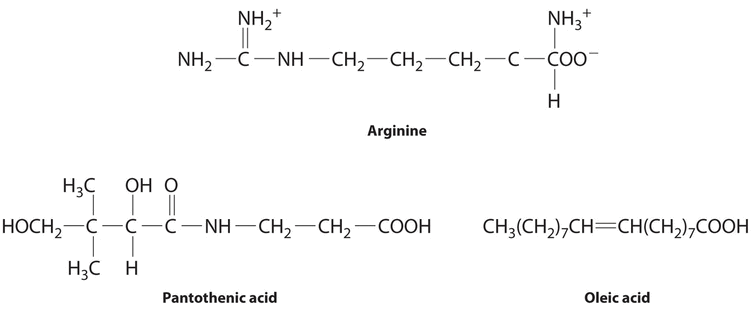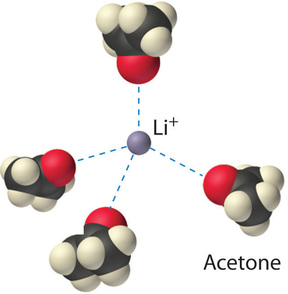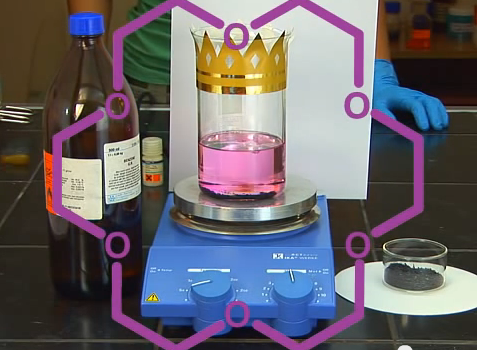what happens to the saturation concentration when a solution is heated
thirteen.2: Saturated Solutions and Solubility
- Page ID
- 21785
Learning Objectives
- To understand the relationship between solubility and molecular structure.
- To demonstrate how the strength of intramolecular bonding determines the solubility of a solute in a given solvent.
When a solute dissolves, its individual atoms, molecules, or ions interact with the solvent, become solvated, and are able to lengthened independently throughout the solution (Figure \(\PageIndex{1a}\)). This is not, however, a unidirectional process. If the molecule or ion happens to collide with the surface of a particle of the undissolved solute, it may attach to the particle in a process called crystallization. Dissolution and crystallization continue as long as backlog solid is nowadays, resulting in a dynamic equilibrium analogous to the equilibrium that maintains the vapor pressure of a liquid. We can stand for these opposing processes as follows:
\[ solute + solvent \underset{crystallization}{\stackrel{dissolution}{\longrightleftharpoons}} solution \]
Although the terms atmospheric precipitation and crystallization are both used to describe the separation of solid solute from a solution, crystallization refers to the formation of a solid with a well-defined crystalline structure, whereas precipitation refers to the formation of any solid phase, oftentimes one with very small particles.

Factors Affecting Solubility
The maximum amount of a solute that can dissolve in a solvent at a specified temperature and pressure is its solubility. Solubility is often expressed as the mass of solute per volume (thou/L) or mass of solute per mass of solvent (g/k), or equally the moles of solute per volume (mol/50). Even for very soluble substances, however, there is usually a limit to how much solute tin can dissolve in a given quantity of solvent. In general, the solubility of a substance depends on non but the energetic factors we accept discussed merely also the temperature and, for gases, the pressure. At twenty°C, for example, 177 g of NaI, 91.two one thousand of NaBr, 35.9 g of NaCl, and only 4.one g of NaF deliquesce in 100 g of water. At 70°C, nevertheless, the solubilities increment to 295 1000 of NaI, 119 yard of NaBr, 37.five g of NaCl, and iv.eight g of NaF. Equally yous learned in Affiliate 12, the lattice energies of the sodium halides increase from NaI to NaF. The fact that the solubilities decrease equally the lattice energy increases suggests that the \(ΔH_2\) term in Figure 13.ane dominates for this serial of compounds.
A solution with the maximum possible amount of solute is saturated. If a solution contains less than the maximum corporeality of solute, it is unsaturated. When a solution is saturated and excess solute is present, the rate of dissolution is exactly equal to the rate of crystallization (Effigy \(\PageIndex{1b}\)). Using the value just stated, a saturated aqueous solution of NaCl, for instance, contains 35.9 g of NaCl per 100 mL of water at xx°C. We tin prepare a homogeneous saturated solution by calculation backlog solute (in this case, greater than 35.9 g of NaCl) to the solvent (water), stirring until the maximum possible amount of solute has dissolved, and and then removing undissolved solute by filtration.
The solubility of almost solids increases with increasing temperature.
Because the solubility of most solids increases with increasing temperature, a saturated solution that was prepared at a college temperature usually contains more dissolved solute than it would incorporate at a lower temperature. When the solution is cooled, information technology tin can therefore become supersaturated (Figure \(\PageIndex{1c}\)). Like a supercooled or superheated liquid, a supersaturated solution is unstable. Consequently, adding a small particle of the solute, a seed crystal, will usually cause the excess solute to speedily precipitate or crystallize, sometimes with spectacular results. The rate of crystallization in Equation \(\ref{xiii.2.1}\) is greater than the rate of dissolution, so crystals or a precipitate course (Figure \(\PageIndex{1d}\)). In contrast, adding a seed crystal to a saturated solution reestablishes the dynamic equilibrium, and the internet quantity of dissolved solute no longer changes.
Video \(\PageIndex{ane}\): hot water ice (sodium acetate) cute science experiment. watered-down sodium acetate trihydrate. Needle crystal is truly wonderful structures
Considering crystallization is the opposite of dissolution, a substance that requires an input of heat to course a solution (\(ΔH_{soln} > 0\)) releases that heat when information technology crystallizes from solution (\(ΔH_{crys} < 0\)). The amount of estrus released is proportional to the amount of solute that exceeds its solubility. 2 substances that have a positive enthalpy of solution are sodium thiosulfate (\(Na_2S_2O_3\)) and sodium acetate (\(CH_3CO_2Na\)), both of which are used in commercial hot packs, small numberless of supersaturated solutions used to warm hands (see Effigy xiii.1.3).
Interactions in Liquid Solutions
The interactions that determine the solubility of a substance in a liquid depend largely on the chemical nature of the solute (such equally whether information technology is ionic or molecular) rather than on its physical state (solid, liquid, or gas). Nosotros will first describe the general case of forming a solution of a molecular species in a liquid solvent and so describe the germination of a solution of an ionic chemical compound.
Solutions of Molecular Substances in Liquids
The London dispersion forces, dipole–dipole interactions, and hydrogen bonds that concur molecules to other molecules are by and large weak. Fifty-fifty so, free energy is required to disrupt these interactions. As described in Section thirteen.one, unless some of that free energy is recovered in the formation of new, favorable solute–solvent interactions, the increase in entropy on solution germination is non enough for a solution to form.
For solutions of gases in liquids, we can safely ignore the energy required to separate the solute molecules (\(ΔH_2 = 0\)) considering the molecules are already separated. Thus nosotros need to consider only the energy required to split the solvent molecules (\(ΔH_1\)) and the energy released by new solute–solvent interactions (\(ΔH_3\)). Nonpolar gases such equally \(N_2\), \(O_2\), and \(Ar\) have no dipole moment and cannot appoint in dipole–dipole interactions or hydrogen bonding. Consequently, the only way they tin interact with a solvent is past means of London dispersion forces, which may be weaker than the solvent–solvent interactions in a polar solvent. Information technology is not surprising, and then, that nonpolar gases are most soluble in nonpolar solvents. In this example, \(ΔH_1\) and \(ΔH_3\) are both small-scale and of similar magnitude. In contrast, for a solution of a nonpolar gas in a polar solvent, \(ΔH_1\) is far greater than \(ΔH_3\). Every bit a result, nonpolar gases are less soluble in polar solvents than in nonpolar solvents. For example, the concentration of \(N_2\) in a saturated solution of \(N_2\) in water, a polar solvent, is only \(7.07 \times 10^{-four}\; Thou\) compared with \(4.5 \times 10^{-3}\; Chiliad\) for a saturated solution of \(N_2\) in benzene, a nonpolar solvent.
The solubilities of nonpolar gases in water generally increase equally the molecular mass of the gas increases, every bit shown in Table \(\PageIndex{1}\). This is precisely the trend expected: as the gas molecules become larger, the forcefulness of the solvent–solute interactions due to London dispersion forces increases, approaching the strength of the solvent–solvent interactions.
| Gas | Solubility (Thousand) × ten−4 |
|---|---|
| He | 3.90 |
| Ne | 4.65 |
| Ar | 15.2 |
| Kr | 27.9 |
| Xe | l.two |
| Htwo | 8.06 |
| N2 | vii.07 |
| CO | 10.6 |
| O2 | xiii.ix |
| N2O | 281 |
| CHiv | 15.5 |
Nearly all common organic liquids, whether polar or non, are miscible. The strengths of the intermolecular attractions are comparable; thus the enthalpy of solution is expected to exist small (\(ΔH_{soln} \approx 0\)), and the increase in entropy drives the formation of a solution. If the predominant intermolecular interactions in two liquids are very different from one another, however, they may be immiscible. For example, organic liquids such as benzene, hexane, \(CCl_4\), and \(CS_2\) (S=C=Southward) are nonpolar and take no power to human action every bit hydrogen bail donors or acceptors with hydrogen-bonding solvents such as \(H_2O\), \(HF\), and \(NH_3\); hence they are immiscible in these solvents. When shaken with h2o, they form dissever phases or layers separated by an interface (Figure \(\PageIndex{2}\)), the region between the two layers.

Just because ii liquids are immiscible, nonetheless, does non mean that they are completely insoluble in each other. For case, 188 mg of benzene dissolves in 100 mL of h2o at 23.5°C. Adding more benzene results in the separation of an upper layer consisting of benzene with a small-scale amount of dissolved water (the solubility of h2o in benzene is only 178 mg/100 mL of benzene). The solubilities of uncomplicated alcohols in h2o are given in Tabular array \(\PageIndex{2}\).
| Alcohol | Solubility (mol/100 k of \(H_2O\)) |
|---|---|
| methanol | completely miscible |
| ethanol | completely miscible |
| n-propanol | completely miscible |
| northward-butanol | 0.11 |
| northward-pentanol | 0.030 |
| north-hexanol | 0.0058 |
| northward-heptanol | 0.0008 |
Just the 3 lightest alcohols (methanol, ethanol, and n-propanol) are completely miscible with water. Every bit the molecular mass of the alcohol increases, so does the proportion of hydrocarbon in the molecule. Correspondingly, the importance of hydrogen bonding and dipole–dipole interactions in the pure alcohol decreases, while the importance of London dispersion forces increases, which leads to progressively fewer favorable electrostatic interactions with h2o. Organic liquids such as acetone, ethanol, and tetrahydrofuran are sufficiently polar to be completely miscible with water yet sufficiently nonpolar to be completely miscible with all organic solvents.

The same principles govern the solubilities of molecular solids in liquids. For example, elemental sulfur is a solid consisting of circadian \(S_8\) molecules that have no dipole moment. Because the \(S_8\) rings in solid sulfur are held to other rings by London dispersion forces, elemental sulfur is insoluble in water. It is, however, soluble in nonpolar solvents that have comparable London dispersion forces, such equally \(CS_2\) (23 g/100 mL). In contrast, glucose contains five –OH groups that tin can class hydrogen bonds. Consequently, glucose is very soluble in water (91 one thousand/120 mL of water) only essentially insoluble in nonpolar solvents such as benzene. The structure of one isomer of glucose is shown hither.

Low-molecular-mass hydrocarbons with highly electronegative and polarizable element of group vii atoms, such as chloroform (\(CHCl_3\)) and methylene chloride (\(CH_2Cl_2\)), accept both meaning dipole moments and relatively strong London dispersion forces. These hydrocarbons are therefore powerful solvents for a broad range of polar and nonpolar compounds. Naphthalene, which is nonpolar, and phenol (\(C_6H_5OH\)), which is polar, are very soluble in chloroform. In contrast, the solubility of ionic compounds is largely adamant not by the polarity of the solvent but rather past its dielectric constant, a measure of its power to separate ions in solution, as you will soon come across.
Example \(\PageIndex{i}\)
Identify the most important solute–solvent interactions in each solution.
- iodine in benzene solvent
- aniline (\(\ce{C_6H_5NH_2}\)) in dichloromethane (\(\ce{CH_2Cl_2}\)) solvent

- iodine in water solvent
Given: components of solutions
Asked for: predominant solute–solvent interactions
Strategy:
Identify all possible intermolecular interactions for both the solute and the solvent: London dispersion forces, dipole–dipole interactions, or hydrogen bonding. Decide which is probable to be the virtually important factor in solution formation.
Solution
- Benzene and \(\ce{I2}\) are both nonpolar molecules. The only possible bonny forces are London dispersion forces.
- Aniline is a polar molecule with a dipole moment of one.6 D and has an \(\ce{–NH_2}\) grouping that can act as a hydrogen bond donor. Dichloromethane is also polar with a ane.5 D dipole moment, merely information technology has no obvious hydrogen bail acceptor. Therefore, the most important interactions between aniline and \(CH_2Cl_2\) are probable to be dipole-dipole interactions.
- Water is a highly polar molecule that engages in extensive hydrogen bonding, whereas \(I_2\) is a nonpolar molecule that cannot deed every bit a hydrogen bail donor or acceptor. The slight solubility of \(\ce{I_2}\) in h2o (\(1.3 \times 10^{-3}\; mol/L\) at 25°C) is due to London dispersion forces.
Exercise \(\PageIndex{i}\)
Identify the about of import interactions in each solution:
- ethylene glycol (\(HOCH_2CH_2OH\)) in acetone
- acetonitrile (\(\ce{CH_3C≡North}\)) in acetone
- n-hexane in benzene
- Answer a
-
hydrogen bonding
- Reply b
-
London interactions
- Respond c
-
London dispersion forces
Hydrophilic and Hydrophobic Solutes
A solute can be classified every bit hydrophilic (literally, "h2o loving"), meaning that information technology has an electrostatic attraction to water, or hydrophobic ("water fearing"), meaning that information technology repels water. A hydrophilic substance is polar and often contains O–H or Northward–H groups that can course hydrogen bonds to water. For instance, glucose with its five O–H groups is hydrophilic. In contrast, a hydrophobic substance may be polar but usually contains C–H bonds that exercise non interact favorably with water, as is the case with naphthalene and n-octane. Hydrophilic substances tend to be very soluble in water and other strongly polar solvents, whereas hydrophobic substances are essentially insoluble in water and soluble in nonpolar solvents such as benzene and cyclohexane.
The divergence between hydrophilic and hydrophobic substances has substantial consequences in biological systems. For example, vitamins can be classified as either fat soluble or water soluble. Fat-soluble vitamins, such every bit vitamin A, are mostly nonpolar, hydrophobic molecules. Equally a issue, they tend to exist absorbed into fatty tissues and stored there. In contrast, water-soluble vitamins, such every bit vitamin C, are polar, hydrophilic molecules that circulate in the blood and intracellular fluids, which are primarily aqueous. Water-soluble vitamins are therefore excreted much more speedily from the body and must be replenished in our daily diet. A comparison of the chemic structures of vitamin A and vitamin C apace reveals why one is hydrophobic and the other hydrophilic.

Because water-soluble vitamins are speedily excreted, the risk of consuming them in excess is relatively small. Eating a dozen oranges a day is likely to brand you tired of oranges long before you suffer any ill effects due to their high vitamin C content. In contrast, fatty-soluble vitamins found a significant wellness adventure when consumed in large amounts. For example, the livers of polar bears and other big animals that live in common cold climates incorporate big amounts of vitamin A, which take occasionally proven fatal to humans who have eaten them.
Example \(\PageIndex{2}\)
The following substances are essential components of the human diet:

Using what you know of hydrophilic and hydrophobic solutes, classify each equally h2o soluble or fat soluble and predict which are likely to exist required in the nutrition on a daily basis.
- arginine
- pantothenic acid
- oleic acrid
Given: chemical structures
Asked for: classification every bit water soluble or fat soluble; dietary requirement
Strategy:
Based on the construction of each compound, decide whether it is hydrophilic or hydrophobic. If information technology is hydrophilic, it is likely to be required on a daily basis.
Solution:
- Arginine is a highly polar molecule with two positively charged groups and 1 negatively charged group, all of which can class hydrogen bonds with water. Equally a result, it is hydrophilic and required in our daily diet.
- Although pantothenic acid contains a hydrophobic hydrocarbon portion, it also contains several polar functional groups (\(\ce{–OH}\) and \(\ce{–CO_2H}\)) that should collaborate strongly with water. It is therefore probable to be water soluble and required in the diet. (In fact, pantothenic acid is almost always a component of multiple-vitamin tablets.)
- Oleic acid is a hydrophobic molecule with a single polar grouping at one end. It should be fat soluble and non required daily.
Exercise \(\PageIndex{2}\)
These compounds are consumed by humans: caffeine, acetaminophen, and vitamin D. Identify each as primarily hydrophilic (water soluble) or hydrophobic (fat soluble), and predict whether each is probable to be excreted from the body quickly or slowly.

- Answer
-
Caffeine and acetaminophen are water soluble and quickly excreted, whereas vitamin D is fat soluble and slowly excreted
Solid Solutions
Solutions are non limited to gases and liquids; solid solutions also exist. For instance, amalgams, which are usually solids, are solutions of metals in liquid mercury. Considering near metals are soluble in mercury, amalgams are used in gold mining, dentistry, and many other applications. A major difficulty when mining gold is separating very small particles of pure gold from tons of crushed rock. One way to accomplish this is to agitate a suspension of the crushed rock with liquid mercury, which dissolves the golden (besides as whatsoever metallic silver that might be present). The very dense liquid gold–mercury amalgam is and so isolated and the mercury distilled away.
An alloy is a solid or liquid solution that consists of i or more than elements in a metal matrix. A solid alloy has a single homogeneous phase in which the crystal structure of the solvent remains unchanged by the presence of the solute. Thus the microstructure of the blend is uniform throughout the sample. Examples are substitutional and interstitial alloys such as brass or solder. Liquid alloys include sodium/potassium and gold/mercury. In dissimilarity, a fractional alloy solution has two or more phases that can be homogeneous in the distribution of the components, just the microstructures of the 2 phases are not the same. As a liquid solution of atomic number 82 and tin is cooled, for case, different crystalline phases class at different cooling temperatures. Alloys usually have backdrop that differ from those of the component elements.
Network solids such equally diamond, graphite, and \(\ce{SiO_2}\) are insoluble in all solvents with which they exercise not react chemically. The covalent bonds that agree the network or lattice together are simply as well strong to be cleaved under normal conditions. They are certainly much stronger than whatsoever believable combination of intermolecular interactions that might occur in solution. Virtually metals are insoluble in near all solvents for the aforementioned reason: the delocalized metal bonding is much stronger than whatever favorable metallic cantlet–solvent interactions. Many metals react with solutions such equally aqueous acids or bases to produce a solution. However, as we saw in Section thirteen.i, in these instances the metallic undergoes a chemical transformation that cannot exist reversed past merely removing the solvent.
Solids with very strong intermolecular bonding tend to exist insoluble.
Solubilities of Ionic Substances in Liquids
Previously, you were introduced to guidelines for predicting the solubility of ionic compounds in water. Ionic substances are more often than not most soluble in polar solvents; the higher the lattice free energy, the more polar the solvent must be to overcome the lattice energy and dissolve the substance. Because of its high polarity, water is the virtually mutual solvent for ionic compounds. Many ionic compounds are soluble in other polar solvents, all the same, such as liquid ammonia, liquid hydrogen fluoride, and methanol. Because all these solvents consist of molecules that have relatively large dipole moments, they can collaborate favorably with the dissolved ions.

The ion–dipole interactions between \(\ce{Li^{+}}\) ions and acetone molecules in a solution of LiCl in acetone are shown in Figure \(\PageIndex{3}\). The energetically favorable \(\ce{Li^{+}}\)–acetone interactions make \(ΔH_3\) sufficiently negative to overcome the positive \(ΔH_1\) and \(ΔH_2\). Considering the dipole moment of acetone (ii.88 D), and thus its polarity, is actually larger than that of water (1.85 D), 1 might fifty-fifty wait that LiCl would be more than soluble in acetone than in water. In fact, the opposite is true: 83 g of LiCl deliquesce in 100 mL of water at twenty°C, but only well-nigh 4.1 g of \(\ce{LiCl}\) dissolve in 100 mL of acetone. This apparent contradiction arises from the fact that the dipole moment is a property of a single molecule in the gas phase. A more than useful mensurate of the ability of a solvent to dissolve ionic compounds is its dielectric abiding (ε), which is the ability of a bulk substance to decrease the electrostatic forces betwixt two charged particles. By definition, the dielectric abiding of a vacuum is one. In essence, a solvent with a high dielectric abiding causes the charged particles to behave as if they have been moved farther apart. At 25°C, the dielectric constant of h2o is 80.1, one of the highest known, and that of acetone is only 21.0. Hence water is better able to subtract the electrostatic attraction between \(\ce{Li^{+}}\) and \(\ce{Cl^{-}}\) ions, so \(\ce{LiCl}\) is more soluble in h2o than in acetone. This beliefs is in contrast to that of molecular substances, for which polarity is the dominant factor governing solubility.
A solvent's dielectric constant is the about useful measure out of its ability to deliquesce ionic compounds. A solvent's polarity is the dominant factor in dissolving molecular substances.

It is also possible to dissolve ionic compounds in organic solvents using crown ethers, cyclic compounds with the general formula \((OCH_2CH_2)_n\). Crown ethers are named using both the total number of atoms in the band and the number of oxygen atoms. Thus eighteen-crown-half dozen is an xviii-membered ring with vi oxygen atoms (Effigy \(\PageIndex{1a}\)). The cavity in the center of the crown ether molecule is lined with oxygen atoms and is large plenty to be occupied past a cation, such equally \(G^+\). The cation is stabilized by interacting with alone pairs of electrons on the surrounding oxygen atoms. Thus crown ethers solvate cations inside a hydrophilic crenel, whereas the outer shell, consisting of C–H bonds, is hydrophobic. Crown ethers are useful for dissolving ionic substances such as \(KMnO_4\) in organic solvents such every bit isopropanol \([(CH_3)_2CHOH]\) (Figure \(\PageIndex{5}\)). The availability of crown ethers with cavities of dissimilar sizes allows specific cations to be solvated with a high caste of selectivity.

Cryptands (from the Greek kryptós, significant "hidden") are compounds that can completely environs a cation with lone pairs of electrons on oxygen and nitrogen atoms (Figure \(\PageIndex{4b}\)). The number in the name of the cryptand is the number of oxygen atoms in each strand of the molecule. Like crown ethers, cryptands can be used to prepare solutions of ionic compounds in solvents that are otherwise also nonpolar to dissolve them.
Summary
The solubility of a substance is the maximum corporeality of a solute that tin dissolve in a given quantity of solvent; it depends on the chemical nature of both the solute and the solvent and on the temperature and pressure level. When a solution contains the maximum corporeality of solute that tin can deliquesce under a given set up of weather condition, information technology is a saturated solution. Otherwise, information technology is unsaturated. Supersaturated solutions, which contain more than dissolved solute than immune under particular conditions, are not stable; the improver of a seed crystal, a small particle of solute, will commonly cause the excess solute to crystallize. A system in which crystallization and dissolution occur at the same charge per unit is in dynamic equilibrium. The solubility of a substance in a liquid is determined by intermolecular interactions, which also decide whether 2 liquids are miscible. Solutes can be classified as hydrophilic (water loving) or hydrophobic (water fearing). Vitamins with hydrophilic structures are water soluble, whereas those with hydrophobic structures are fat soluble. Many metals dissolve in liquid mercury to course amalgams. Covalent network solids and almost metals are insoluble in almost all solvents. The solubility of ionic compounds is largely determined by the dielectric constant (ε) of the solvent, a measure of its ability to decrease the electrostatic forces betwixt charged particles. Solutions of many ionic compounds in organic solvents can exist dissolved using crown ethers, cyclic polyethers large enough to arrange a metallic ion in the heart, or cryptands, compounds that completely surround a cation.
pritchardwhie1969.blogspot.com
Source: https://chem.libretexts.org/Bookshelves/General_Chemistry/Map:_Chemistry_-_The_Central_Science_%28Brown_et_al.%29/13:_Properties_of_Solutions/13.2:_Saturated_Solutions_and_Solubility
0 Response to "what happens to the saturation concentration when a solution is heated"
Post a Comment